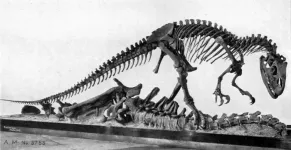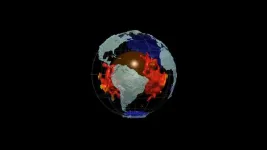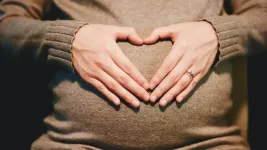(Press-News.org) Carnivorous dinosaurs might have evolved to take advantage of giant carcasses, according to a study published November 1, 2023 in the open-access journal PLOS ONE by Cameron Pahl and Luis Ruedas of Portland State University, Oregon and colleagues.
Carnivorous dinosaurs lived in ecosystems rich with both living and dead prey. The authors hypothesize that giant carcasses, like those of sauropod dinosaurs, might have provided a major source of food for large carnivores. To test this hypothesis, the researchers created an agent-based model, a simplified virtual simulation of a dinosaur ecosystem. This model was based on the ancient fauna of the Jurassic-aged Morrison Formation, which included large predators like Allosaurus alongside large sauropods, their carcasses, and an infinite supply of huntable stegosaurs.
In the model, carnivores (intended to simulate allosaurs) were assigned traits that would improve their hunting or scavenging abilities while obtaining energy from meat sources (simulating living prey or sauropod carcasses). The model measured the evolutionary fitness of these simulated carnivores and found that, when large sources of sauropod carrion were available, scavenging was more profitable than hunting, suggesting that carnivores in such ecosystems might have evolved specialized traits to help them detect and exploit large carcasses.
The authors stress that this model represents a simplified abstract of a complex system, and that the results might be altered with the inclusion of more variables, such as additional dinosaur species or features of the life history of the simulated dinosaurs. They note that models like this might improve our understanding of how the availability of carrion can influence the evolution of predators.
The authors add: “Our evolutionary model demonstrates that large theropods such as Allosaurus could have evolved to subsist on sauropod carrion as their primary resource. Even when huntable prey was available to them, selection pressure favored the scavengers, while the predators suffered from lower fitness. So we think allosaurs probably waited until a bunch of sauropods died in the dry season, feasted on their carcasses, stored the fat in their tails, then waited until the next season to repeat the process. This makes sense logically too, because a single sauropod carcass had enough calories to sustain 25 or so allosaurs for weeks or even months, and sauropods were often the most abundant dinosaurs in the environment.”
#####
In your coverage please use this URL to provide access to the freely available article in PLOS ONE: https://journals.plos.org/plosone/article?id=10.1371/journal.pone.0290459
Citation: Pahl CC, Ruedas LA (2023) Big boned: How fat storage and other adaptations influenced large theropod foraging ecology. PLoS ONE 18(11): e0290459. https://doi.org/10.1371/journal.pone.0290459
Author Countries: USA
Funding: The authors received no specific funding for this work.
END
Giant dinosaur carcasses might have been important food sources for Jurassic predators
Simulation indicates traits for exploiting carrion could have been key to success
2023-11-01
ELSE PRESS RELEASES FROM THIS DATE:
Game performance of immigrant NBA players might suffer in context of far-right political support
2023-11-01
During the 2020-2021 season of the National Basketball Association (NBA), which took place during Donald Trump’s failed bid at re-election, immigrant players for teams in regions with stronger far-right political sentiments were more likely to make game errors—highlighting the possible detrimental effects of such views on immigrant workplace performance. Benjamin Korman and Florian Kunze of the University of Konstanz, Germany, present these findings in the open-access journal PLOS ONE on November 1.
Prior research ...
Gulf War Illness significantly reduces white blood cells’ ability to make energy
2023-11-01
DURHAM, N.C.— A new Duke University-led study finds that Gulf War Illness (GWI), which affects approximately 250,000 U.S. veterans, significantly reduces their white blood cells’ ability to make energy and creates a measurable biochemical difference in veterans who have the disease.
“Historically, GWI has been diagnosed based on a veteran’s self-reported symptoms, such as exercise-induced fatigue, indigestion, dizziness, insomnia, or memory problems. There’s been no objective biochemical or molecular measurements doctors could use to diagnose it,” said Joel Meyer, professor of environmental genomics ...
Wistar scientists engineer new NK cell engaging immunotherapy approaches to target and potentially treat recalcitrant ovarian cancer
2023-11-01
PHILADELPHIA—(Nov. 1, 2023)—The Wistar Institute’s David B. Weiner, Ph.D., executive vice president, director of the Vaccine & Immunotherapy Center (VIC) and W.W. Smith Charitable Trust Distinguished Professor in Cancer Research, and collaborators, have engineered novel monoclonal antibodies that engage Natural Killer cells through a unique surface receptor that activates the immune system to fight against cancer.
In their publication titled, “Siglec-7 glyco-immune binding MAbs or NK ...
PLOS Complex Systems and PLOS Mental Health now open for submissions!
2023-11-01
SAN FRANCISCO —The Public Library of Science (PLOS) is pleased to announce that PLOS Complex Systems and PLOS Mental Health are now open for submissions. Both journals have a strong community of editors who will represent the full diversity of the research communities we aim to serve.
PLOS Mental Health is an inclusive journal led by Editors-in-Chief Charlene Sunkel and Rochelle Burgess, working alongside staff Executive Editor Karli Montague-Cardoso and in collaboration with a diverse Editorial Board. The journal is seeking research that addresses challenges and gaps in the field of mental health research, ...
The remains of an ancient planet lie deep within Earth
2023-11-01
In the 1980s, geophysicists made a startling discovery: two continent-sized blobs of unusual material were found deep near the center of the Earth, one beneath the African continent and one beneath the Pacific Ocean. Each blob is twice the size of the Moon and likely composed of different proportions of elements than the mantle surrounding it.
Where did these strange blobs—formally known as large low-velocity provinces (LLVPs)—come from? A new study led by Caltech researchers suggests that they are remnants of an ancient planet that violently collided with Earth billions of years ago in the same giant impact that created ...
New twist on optical tweezers
2023-11-01
Optical tweezers manipulate tiny things like cells and nanoparticles using lasers. While they might sound like tractor beams from science fiction, the fact is their development garnered scientists a Nobel Prize in 2018.
Scientists have now used supercomputers to make optical tweezers safer to use on living cells with applications to cancer therapy, environmental monitoring, and more.
“We believe our research is one significant step closer towards the industrialization of optical tweezers in biological applications, specifically in both selective cellular surgery and targeted drug delivery,” ...
Stigma felt by opioid-dependent moms impacts the health care received by their babies
2023-11-01
COLUMBIA, Mo. -- The rate of opioid use among pregnant women in the United States quadrupled between 1999 and 2014 and continues to rise — an alarming trend that researchers from the University of Missouri and University of Iowa say has exposed the stigma felt by opioid-dependent mothers and how their shame has negatively impacted the health care received by their infants.
Jamie Morton led a study, which was a metasynthesis of existing literature on the topic, as a doctoral student at the MU Sinclair School of Nursing. She said the findings can help ensure health care providers, family ...
The ringed seals in Ilulissat Icefjord, Greenland are special
2023-11-01
Exploring Arctic nature can be difficult. Harsh conditions and great distances are significant challenges when researchers want to coax secrets out of nature.
However, a research project, led by Greenlandic and Danish researchers, has now succeeded in describing a new type of ringed seal that lives in the Icefjord near Ilulissat in West Greenland; a unique natural area on the UNESCO World Heritage List.
The results have just been published in the renowned scientific journal Molecular Ecology.
A small population
Over ...
NRL ISS Mission seeks new bioinspired materials
2023-11-01
WASHINGTON – The U.S. Naval Research Laboratory’s Melanized Microbes for Multiple Uses in Space Project, or MELSP, will use the International Space Station (ISS) to search for production of melanin variants and other useful biomaterials that can have applications both on Earth and in space. The mission is scheduled to launch in early November 2023.
Melanin is described as a group of biopolymers responsible for various biological functions, including pigmentation of skin, hair, and iris of the eyes, which helps protect body ...
Pinpointing HIV immune response
2023-11-01
New research combining computer modeling and experiments with macaques shows the body’s immune system helps control human immunodeficiency virus (HIV) infections largely by suppressing viral production in already infected cells while also killing viral infected cells, but only within a narrow time window at the start of a cell’s infection.
“To eliminate HIV, we have to understand how the immune system attempts to control the infection,” said Ruy M. Ribeiro, a theoretical biologist at Los Alamos National Laboratory who led the development of the model ...
LAST 30 PRESS RELEASES:
Decoupling the HOR enhancement on PtRu: Dynamically matching interfacial water to reaction coordinates
Sulfur isn’t poisonous when it synergistically acts with phosphine in olefins hydroformylation
URI researchers uncover molecular mechanisms behind speciation in corals
Chitin based carbon aerogel offers a cleaner way to store thermal energy
Tracing hidden sources of nitrate pollution in rapidly changing rural urban landscapes
Viruses on plastic pollution may quietly accelerate the spread of antibiotic resistance
Three UH Rainbow Babies & Children’s faculty elected to prestigious American Pediatric Society
Tunnel resilience models unveiled to aid post-earthquake recovery
Satellite communication systems: the future of 5G/6G connectivity
Space computing power networks: a new frontier for satellite technologies
Experiments advance potential of protein that makes hydrogen sulfide as a therapeutic target for Alzheimer’s disease
Examining private equity’s role in fertility care
Current Molecular Pharmacology achieves a landmark: real-time CiteScore advances to 7.2
Skeletal muscle epigenetic clocks developed using postmortem tissue from an Asian population
Estimating unemployment rates with social media data
Climate policies can backfire by eroding “green” values, study finds
Too much screen time too soon? A*STAR study links infant screen exposure to brain changes and teen anxiety
Global psychiatry mourns Professor Dan Stein, visionary who transformed mental health science across Africa and beyond
KIST develops eco-friendly palladium recovery technology to safeguard resource security
Statins significantly reduce mortality risk for adults with diabetes, regardless of cardiovascular risk
Brain immune cells may drive more damage in females than males with Alzheimer’s
Evidence-based recommendations empower clinicians to manage epilepsy in pregnancy
Fungus turns bark beetles’ defenses against them
There are new antivirals being tested for herpesviruses. Scientists now know how they work
CDI scientist, colleagues author review of global burden of fungus Candida auris
How does stroke influence speech comprehension?
B cells transiently unlock their plasticity, risking lymphoma development
Advanced AI dodel predicts spoken language outcomes in deaf children after cochlear implants
Multimodal imaging-based cerebral blood flow prediction model development in simulated microgravity
Accelerated streaming subgraph matching framework is faster, more robust, and scalable
[Press-News.org] Giant dinosaur carcasses might have been important food sources for Jurassic predatorsSimulation indicates traits for exploiting carrion could have been key to success








